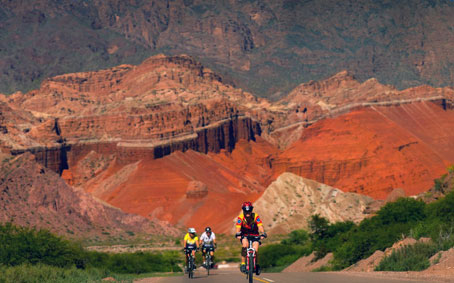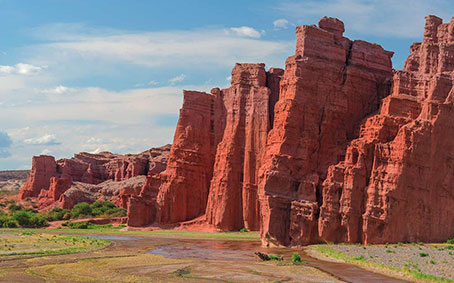Argentina . Cafayate
Passports: anyone entering Argentina should have a passport valid for at least six months from date of entry, and ideally past the date the passport holder leaves the country.
** VERY IMPORTANT: ALL PASSENGERS MUST TRAVEL WITH THE PASSPORT INFORMED AT THE TIME OF BOOKING **
Visas: nationals of Canada, most Western European countries, Australia and New Zealand do not need a visa to visit Argentina. Upon arrival, most visitors get a 90-day stamp in their passport. Canadians must pay a ‘reciprocity fee’ before arriving. Ideally it will be reminded when buying the airplane ticket: this fee is equal to what Argentines are charged for visas to visit those countries. The fee is paid online and with a credit card.
Customs Regulations: electronic items (laptops, cameras and mobile phones) can be brought into the country duty free, provided they are not intended for resale. If you have a lot of equipment, it is recommended to take an item list with the serial numbers and preferably the purchase receipts.
Electricity: Argentina’s electric current operates on 220V; 50Hz; plugs are C/I type. Adapters are readily available from almost any ferretería (hardware store). Most electronic equipment (such as cameras, telephones and computers) are dual/multi-voltage, but some equipment may require a voltage converter or you might short out your device.
Internet Access: Wi-Fi is available at most hotels, cafes, restaurants and airports, and it’s generally good and free. In remote spots like El Chaltén and other parts of Patagonia Wi-Fi service may be usually poor.
Mobile Phones: it’s best to bring your own unlocked tri- or quad-band GSM cell phone to Argentina, then buy an inexpensive SIM chip (you’ll get a local number) and credits (or carga virtual) as needed. All SIM Cards now must be registered to users before they can be activated. In theory, a foreigner can activate a SIM card with identification. Both SIM chips and credits can be bought at many kiosks or “locutorios”.
Money: ATMs are widely available and credit cards are accepted in most hotels and restaurants. ATMs can also be used for cash advances on major credit cards (not all foreign cards work in ATMs). They’re the best way to get money, and nearly all have instructions in English. Limits on withdrawal can be very low, though the withdrawal fee can be relatively high. Banelco ATMs tend to allow larger withdrawals. In some spots in Patagonia (El Calafate and El Chaltén, e.g.) and most touristic destinations they quickly run out of cash in high season.
Cash: the Argentine unit of currency is the peso (AR$). Notes come in denominations of 10, 20, 50, 100, 200, 500, 1.000, 2.000, 10.000 and 20.000 pesos. One peso equals 100 “centavos”; coins come in denominations of 10, 25 and 50 centavos, as well as 1, 2, 5 and 10 pesos. Currently, US dollars are accepted by many companies dedicated to tourism, but it is always recommended to carry some pesos.
Credit Cards: many (but not all!) tourist services, larger stores, hotels and restaurants – especially in the bigger cities – take credit cards. The most widely accepted are Visa and MasterCard, though American Express and a few others are valid in some establishments. Important: many places will give a small discount if you pay in cash rather than use a credit card.
Money Changers: US dollars are by far the preferred foreign currency, although Chilean and Uruguayan pesos can be readily exchanged at the borders. Cash dollars and Euros can be changed at banks and “casas de cambios” (exchange houses) in larger cities, but other currencies can be difficult to change outside Buenos Aires. Passport is needed to change money; we strongly suggest avoiding any sort of street-tout money changer.
Tipping: restaurants and cafes: it’s customary to tip about 10% of the bill. Spa: 15% of the bill. Hotel staff, delivery people, hotel and bus porters and taxi drivers: give a few bills.
Opening Hours:
Banks 10 am to 3 pm Monday to Friday.
Bars 7 pm / 9 pm to 4 am / 6 am nightly.
Cafes 6 am to midnight or much later; open daily.
Clubs 1 am / 2 am to 6 am / 8 am Friday and Saturday.
Office business hours 9 am to 6 pm.
Restaurants Noon to 3:30 pm and 8 pm to midnight or 1am (later on weekends).
Shops 9 am / 10 am to 8 pm / 9 pm Monday to Saturday.
Mention Argentina, and people think about solitary gauchos or maybe tango dancers. It is country blessed with abundant natural resources and a highly educated population. The country boasts a wide variety of cultural attractions, but for many travelers, its natural wonders are the primary draw. From the northern deserts down to the southern Andean Cordillera, from the Iguazú Falls to the magnificent desolation of Patagonia, Argentina's geography is varied and stunning. For cosmopolitan types, there's the elegant capital, Buenos Aires. This fabulous city is renowned for its sophistication, although travelers expecting a more 'South American' experience are sometimes disappointed with its European touch.
It's a large country - the eighth largest in the world, and the second largest on the South American continent. It borders Chile to the west (separated by the Andean Cordilleras range) and Uruguay, Paraguay, Brazil and Bolivia to the north and east (separated by rivers). It also shares the offshore island territory of Tierra del Fuego with Chile, and continues claiming the possession of the Malvinas Islands (Falkland Islands) and the Antarctic territory, where Argentina has installed several scientific bases, including the most famous: Marambio.
Argentina's topography is affected by both latitude and altitude, and is accordingly varied. The country can be divided into four major physiographic provinces: the Andes to the west (with arid basins, grape-filled foothills, glacial mountains and the Lake District), the fertile lowland north (with subtropical rainforests), the central Pampas (a flat mixture of humid and dry expanses) and Patagonia (a combination of pastoral steppes and glacial regions).
Population: 46 million (2022 CENSUS)
Capital city: Buenos Aires
People: 85% European descent, 15% mestizo, native and other minorities
Language: American Spanish, plus 17 native languages
Religion: 93% Roman Catholic, 2.5% protestant, 2% Jewish, 1.5% Ukrainian catholic, 1% Armenian orthodox








